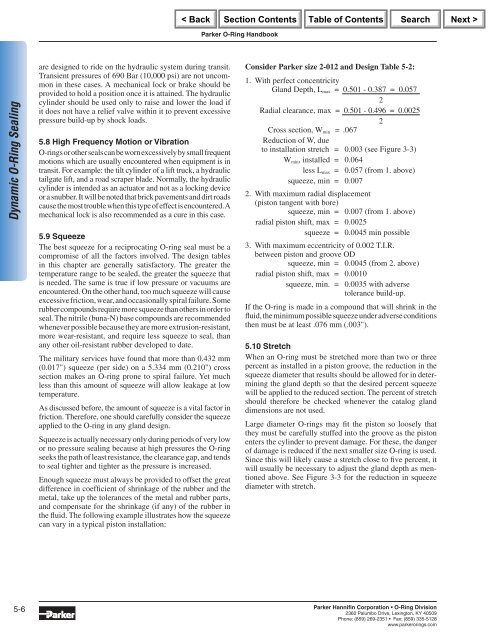Parker O-Ring Handbook.pdf
Parker O-Ring Handbook.pdf
Parker O-Ring Handbook.pdf
Create successful ePaper yourself
Turn your PDF publications into a flip-book with our unique Google optimized e-Paper software.
Dynamic O-<strong>Ring</strong> Sealing<br />
5-6<br />
are designed to ride on the hydraulic system during transit.<br />
Transient pressures of 690 Bar (10,000 psi) are not uncommon<br />
in these cases. A mechanical lock or brake should be<br />
provided to hold a position once it is attained. The hydraulic<br />
cylinder should be used only to raise and lower the load if<br />
it does not have a relief valve within it to prevent excessive<br />
pressure build-up by shock loads.<br />
5.8 High Frequency Motion or Vibration<br />
O-rings or other seals can be worn excessively by small frequent<br />
motions which are usually encountered when equipment is in<br />
transit. For example: the tilt cylinder of a lift truck, a hydraulic<br />
tailgate lift, and a road scraper blade. Normally, the hydraulic<br />
cylinder is intended as an actuator and not as a locking device<br />
or a snubber. It will be noted that brick pavements and dirt roads<br />
cause the most trouble when this type of effect is encountered. A<br />
mechanical lock is also recommended as a cure in this case.<br />
5.9 Squeeze<br />
The best squeeze for a reciprocating O-ring seal must be a<br />
compromise of all the factors involved. The design tables<br />
in this chapter are generally satisfactory. The greater the<br />
temperature range to be sealed, the greater the squeeze that<br />
is needed. The same is true if low pressure or vacuums are<br />
encountered. On the other hand, too much squeeze will cause<br />
excessive friction, wear, and occasionally spiral failure. Some<br />
rubber compounds require more squeeze than others in order to<br />
seal. The nitrile (buna-N) base compounds are recommended<br />
whenever possible because they are more extrusion-resistant,<br />
more wear-resistant, and require less squeeze to seal, than<br />
any other oil-resistant rubber developed to date.<br />
The military services have found that more than 0.432 mm<br />
(0.017") squeeze (per side) on a 5.334 mm (0.210") cross<br />
section makes an O-ring prone to spiral failure. Yet much<br />
less than this amount of squeeze will allow leakage at low<br />
temperature.<br />
As discussed before, the amount of squeeze is a vital factor in<br />
friction. Therefore, one should carefully consider the squeeze<br />
applied to the O-ring in any gland design.<br />
Squeeze is actually necessary only during periods of very low<br />
or no pressure sealing because at high pressures the O-ring<br />
seeks the path of least resistance, the clearance gap, and tends<br />
to seal tighter and tighter as the pressure is increased.<br />
Enough squeeze must always be provided to offset the great<br />
difference in coeffi cient of shrinkage of the rubber and the<br />
metal, take up the tolerances of the metal and rubber parts,<br />
and compensate for the shrinkage (if any) of the rubber in<br />
the fl uid. The following example illustrates how the squeeze<br />
can vary in a typical piston installation:<br />
<strong>Parker</strong> O-<strong>Ring</strong> <strong>Handbook</strong><br />
Consider <strong>Parker</strong> size 2-012 and Design Table 5-2:<br />
1. With perfect concentricity<br />
Gland Depth, Lmax = 0.501 - 0.387 = 0.057<br />
2<br />
Radial clearance, max = 0.501 - 0.496 = 0.0025<br />
2<br />
Cross section, Wmin = .067<br />
Reduction of W, due<br />
to installation stretch = 0.003 (see Figure 3-3)<br />
Wmin, installed = 0.064<br />
less Lmax = 0.057 (from 1. above)<br />
squeeze, min = 0.007<br />
2. With maximum radial displacement<br />
(piston tangent with bore)<br />
squeeze, min = 0.007 (from 1. above)<br />
radial piston shift, max = 0.0025<br />
squeeze = 0.0045 min possible<br />
3. With maximum eccentricity of 0.002 T.I.R.<br />
between piston and groove OD<br />
squeeze, min = 0.0045 (from 2. above)<br />
radial piston shift, max = 0.0010<br />
squeeze, min. = 0.0035 with adverse<br />
tolerance build-up.<br />
If the O-ring is made in a compound that will shrink in the<br />
fl uid, the minimum possible squeeze under adverse conditions<br />
then must be at least .076 mm (.003").<br />
5.10 Stretch<br />
When an O-ring must be stretched more than two or three<br />
percent as installed in a piston groove, the reduction in the<br />
squeeze diameter that results should be allowed for in determining<br />
the gland depth so that the desired percent squeeze<br />
will be applied to the reduced section. The percent of stretch<br />
should therefore be checked whenever the catalog gland<br />
dimensions are not used.<br />
Large diameter O-rings may fi t the piston so loosely that<br />
they must be carefully stuffed into the groove as the piston<br />
enters the cylinder to prevent damage. For these, the danger<br />
of damage is reduced if the next smaller size O-ring is used.<br />
Since this will likely cause a stretch close to fi ve percent, it<br />
will usually be necessary to adjust the gland depth as mentioned<br />
above. See Figure 3-3 for the reduction in squeeze<br />
diameter with stretch.<br />
<strong>Parker</strong> Hannifi n Corporation • O-<strong>Ring</strong> Division<br />
2360 Palumbo Drive, Lexington, KY 40509<br />
Phone: (859) 269-2351 Fax: (859) 335-5128<br />
www.parkerorings.com

















